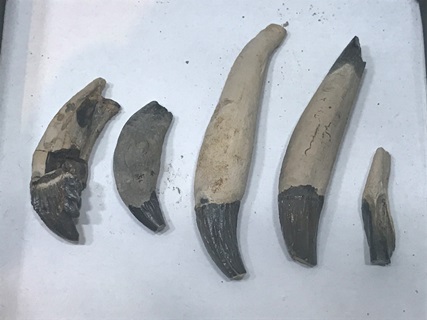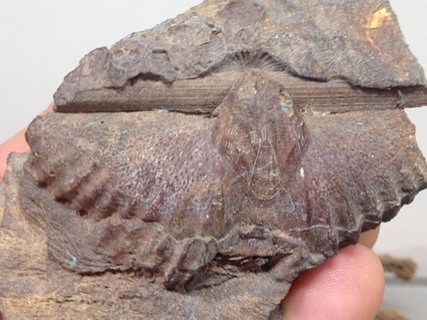Vertebrate Fossils

The first vertebrate fossil I found was remarkable, a large whale bone in early Miocene coastal sediment. The bone appears to be the end of a rib and tapers to a nice point. At its thickest point it measures approx. 60mm x 20mm, and the fragment is approximately 400mm in length. This would have belonged to a massive creature, most likely a toothed whale, as these were not uncommon at this time, although to my knowledge none as large as this have yet been described from the Southern Victorian coast.
I have since found three more rib fragments plus an assemblage of ribs and dorsal spines that appear likely to have come from much smaller small whales or dolphins, quite possibly Janjucetus. One is in very good condition and has a beautiful oval cross section. One is almost circular in cross section, and the third, while in poor condition, appears to be the terminal part that would have joined to the spine.
Whale teeth are amazing. So far I have collected five from one site, over multiple visits, although one is very damaged. They belong to squaladon (shark-toothed) whales, possibly Janjucetus

One bone was badly damaged and I repaired it with superglue. It has an instantly recognizable "bone-like" end to it, and my best guess is that this may actually have belonged to a small reptile or mammal, though it was found in marine sediment, so I don't know how it got there. Perhaps it is a bird bone, though these are supposed to be hollow and the bone doesn't look like it was hollow.
I have found several small jaw bones, the best examples of which are complete and contain many fine teeth. My best guess is that they belonged to something like an eel. Actually, the rocks in which I found these, and the large number of small bone fragments make me think these blobs are actually coprolites, fossil poo of some predator, perhaps a large fish or a shark.
I have found two fossil shark teeth. One is definitely of the genus Charcharadon, which includes the modern day white pointer and the prehistoric Megalodon. It is a lovely specimen, though the tip is broken. It is about 30mm wide at the base, and would have been about 40mm long before it was broken, so belonged to a huge and terrifying shark. The second shark tooth is also a lovely specimen though much smaller. It is approximately 6mm wide and 12mm long, and has a miniature tooth growing next to it. Both teeth show magnificent dark coloration from their great age, yet are as shiny and unworn as if these sharks had only just dropped them. They are also very sharp.
I recently found a small bundle of unusual fossils that I have decided are most likely fish ribs.
One bone is a bit of an enigma but I suspect it might be part of a skull. It is about 60x30x5mm.
Continue to the photo gallery »
Invertebrate fossils

It is quite incredible how well preserved shells can be after 25 million years or so. They look pretty much as if they had been buried last week. They're a lot more fragile of course. I have found a few nautilus fossils, however they are usually much too fragile to recover. One exception to this was a partial nautilus I collected about a year ago. It has fossilized into a harder rock than is usual, and I was able to obtain about a quarter of the original shell.

One of the first fossils I found was sea urchin. Since then I have found several different varieties. One interesting aspect to it is that you can occasionally find modern urchin shells at the same general location. The sheer number of urchin fossils at some sites is remarkable. It is hard to imagine how so many of them could have been fossilized in the same place, unless they existed at extraordinary densities. Also it is amazing how often urchin fossils are in perfect condition. The modern shells are very easy to break, yet the prehistoric varieties are more often than not completely unbroken. Large prehistoric urchin spines are another major item in my collection. The longest is about 300mm in length, so the animal must have been huge, bigger than a basketball in size. I have never seen a living urchin come close to that size. They must have been fairly common as well, since I Have found several spines of that size, at different sites.
I have found graptolites at two locations, both shale quarries in central Victoria. They are very nice fossils and possibly the oldest items in my collection at over 400 million years old.
Continue to the photo gallery »
Plant fossils
I visited cape Patterson a few years ago, and had planned on doing some collecting while I was there, but the place seemed really special and I felt like it would have been vandalism to use my hammer there. I saw some amazing fossilized trees lying in the ground. Apparently it was a forest during the Jurassic when these sediments were laid down, and with a bit of imagination you could imagine these trees when they were alive. I kept a few loose fragments.

